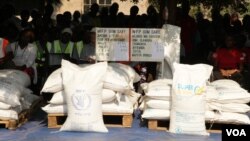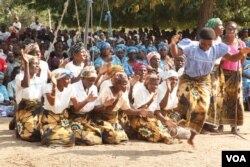Malawi and the World Food Program or WFP have started distribution of relief food to people in 24 of the country’s 28 districts worst hit by food shortages.
Traditional dance was one of the activities at the launch of the Malawi’s largest ever humanitarian response.
This comes three months after findings of the Malawi Vulnerability Assessment Committee showed that 6.5 million people, nearly half of Malawi’s population, will require food assistance until the next harvest season.
The committee attributed the food shortage situation to drought and the El Nino weather phenomenon which affected this year’s harvests.
Malawi’s vice president Saulos Chilima presided over the launch.
He told the gathering that the situation requires a quick response to save people’s lives.
“We are not rehearsing a response plan. It is not jokes. We have to work hard to avoid losing people’s lives. Any mistake we make here somebody will lose their lives,” said Chilima.
Out of 6.5 million people who need of food aid in Malawi, the WFP says it is targeting 5.8 million of them.
The remaining 650,000 people will be supported by the Malawi government and other development partners.
Coco Ushiyama, country director for the WFP in Malawi, said the distribution needs to be done quickly especially in the flood-hit areas in southern Malawi.
“The year it’s also La Nina [coming]. La Nina in this region is usually [associated with] floods. So what we might see is that unless we preposition the significant amount of food, especially in the south of Malawi before the rain come we will be in trouble,” said Ushiyama.
Nearly 90 percent of the households in need of food in Nsanje district have received aid.
Malita Boniface is one of the beneficiaries.
The mother of four children said she did not harvest anything from her three hectares maize garden because of the drought.
“Getting something to eat has been a big challenge. Sometimes we would survive on nyika [water lily] and it becomes hard for children to eat it raw. Instead we peel and mill it so that we can use its flour to cook porridge for children,” said Boniface.
Food items the beneficiaries receive include sorghum, beans and maize flour.
Food distribution is expected to end in March, the start of harvest season in Malawi.








